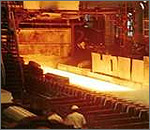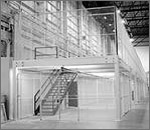Steel is an alloy of carbon and iron (the metallic element, not the finished product). It contains less carbon (0.2 to 1.5%) than cast iron, but more than wrought iron. High-carbon steel is

harder and more brittle, while lower carbon content makes the product softer and easier to work.
Usually traces of such other metal oars as chromium, nickel, copper, tungsten, etc. are also added to produce kinds of steel with slightly different characteristics.
The production of steel requires the removal of more of the impurities in iron ore than iron production does, often through the application of greater heat than ancient furnaces could produce.
It is easy to think of steel as iron ore to which carbon is added, but in actual production it was often cast iron from which carbon was removed, a process called "decarburizing," and several processes for accomplishing this were used beginning in the Han dynasty (206 BC - AD 220).
In general, steel is an improvement over iron in being less brittle, but its characteristics vary by the amount of carbon in the alloy. The introduction of other metallic ores allows the production of special purpose steels, such as stainless steel, made with chromium.

An important technique in modern and late historic steel production is "quenching," that is, heating the metal and then rapidly lowering its temperature again by plunging it into water.(See below.) The result is a dramatic increase in the strength of the metal, strength which can be increased yet further by repeating the process. The earliest quench-hardened steel that we know about dates from about 1200 BC or so. (Homer refers to the process.) But steel was too difficult to produce dependably to come into wide use at that point.
Obviously there is a fine line between iron and steel, and some metallic products are difficult to classify as quite one or quite the other. Techniques for raising furnace temperatures, controlling carbon content, and quenching after raising the metal to just the right temperature were central to the production of iron-ore based tools thatwereactually superior to bronze ones rather than merely cheaper.


